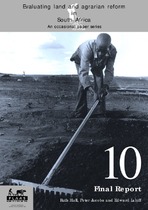| dc.contributor.author | Hall, Ruth | |
| dc.contributor.author | Jacobs, Peter | |
| dc.contributor.author | Lahiff, Edward | |
| dc.date.accessioned | 2019-03-07T11:54:26Z | |
| dc.date.available | 2019-03-07T11:54:26Z | |
| dc.date.issued | 2003 | |
| dc.identifier.citation | Hall, R., Jacobs, P. & Lahiff, E., 2003. Final report. Cape Town: Institute for Poverty Land and Agrarian Studies. | en_US |
| dc.identifier.isbn | 1-86808-588-0 | |
| dc.identifier.uri | http://hdl.handle.net/10566/4414 | |
| dc.description.abstract | Land dispossession was a key feature of racism under colonial rule and apartheid in South Africa. More than 3.5 million people were forcibly removed in the period 1960 to 1983 alone, through homeland consolidation, removals from ‘black spots’ and the Group Areas Act. One result of massive dispossession is the concentration of poverty in South Africa’s rural areas, where about 70% of the population lives below the poverty line (May 1998).
The prospect of democracy in the 1990s raised expectations that the dispossessed would be able to return to their land, but the terms on which political transition was negotiated constrained how this could happen. Despite calls for a radical restructuring of social relations in the countryside, the constitutional negotiations on the protection of property rights, and on the economy more broadly, ensured that land reform would be pursued within the framework of a market-led land reform model, as advocated by the World Bank and implemented in countries such as Brazil, Colombia and Zimbabwe. | en_US |
| dc.language.iso | en | en_US |
| dc.publisher | Institute for Poverty Land and Agrarian Studies (PLAAS) | en_US |
| dc.relation.ispartofseries | Evaluating land and agrarian reform in South Africa;10 | |
| dc.subject | Land redistribution | en_US |
| dc.subject | Land restitution | en_US |
| dc.subject | Farm tenure | en_US |
| dc.title | Evaluating land and agrarian reform
in
South Africa : Final Report | en_US |
| dc.type | Book | en_US |

